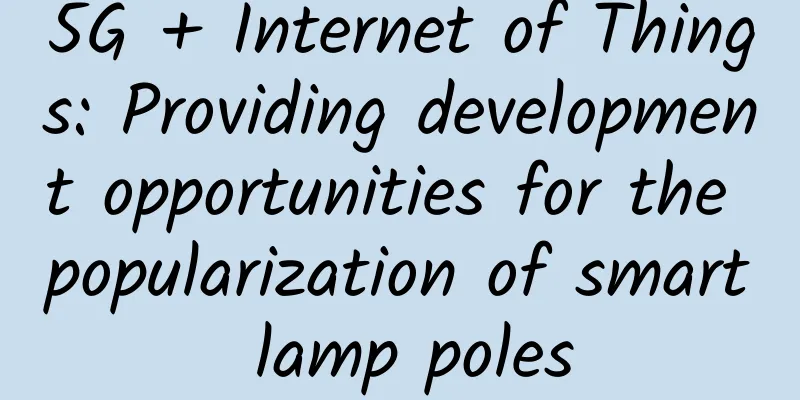5G + Internet of Things: Providing development opportunities for the popularization of smart lamp poles

|
At present, the smart light pole industry is still in its early stages of development, relevant industry standards have not yet been formed, and participants are mixed. Industry insiders said that the development cycle of smart light poles is long, the initial investment is large, and companies generally do not have the research and development capabilities; at the same time, smart light poles have not been fully accepted by the market, and are currently in the pilot stage, with insufficient market demand. So, when will smart light poles be popularized? Difficulties in popularizing smart lamp polesSmart light poles were only introduced in 2015 and commercialized in 2016. Currently, the industry is in its infancy in China. In my country, there is still a lot of room for infrastructure construction and many new districts are still under construction. In the initial road planning stage, there is already room for the development of smart light poles. Recently, more and more smart light poles have been applied in various regions; some old urban areas have also installed smart street lights, but due to the line modification involved, they are currently less used. As of the end of September 2018, more than 25 provinces/municipalities have launched smart street light projects, including Beijing, Shanghai, Shenzhen, Tianjin, Chongqing, Jiangsu, Fujian, etc. There are also many problems in the promotion of smart light poles, such as untimely feedback on street light failures, incomplete solutions, low efficiency in post-maintenance and data collection, low efficiency in communication and collaboration between implementation departments and maintenance departments, and poor substitutability. 5G+IoT promotes the popularization of smart lamp polesFrom an objective perspective, the success of the promotion of smart cities is closely related to the popularity of IoT devices, the maturity of broadband network deployment, the data transmission volume and computing power of cloud data centers, etc. Therefore, the deployment of 5G base stations through street lamp poles will hopefully drive the accelerated implementation of smart cities and will also be closely linked to the transformation and development of the 5G era. Compared with macro base stations, small base stations have the advantages of small size, power consumption, high integration, and convenient deployment. Therefore, the 5G era will give rise to huge demand for small base stations. There are three main ways to install small base stations: pole installation, floor installation, and ground installation. Smart lamp poles are one of the most feasible pole installation methods for installing small base stations, which will give rise to a large amount of demand. The construction of 5G has just begun. According to the development laws of 2G, 3G, and 4G, it is estimated that within 2 to 3 years, communication operators will focus on the construction of macro stations. After 5G is commercialized on a large scale, the construction of micro stations will gradually explode, thereby detonating the smart lamp pole market. At present, the Internet of Things is widely used in smart parking, smart cities, smart production, smart homes and other fields. The development of the Internet of Things will make smart lamp poles more "intelligent". Using the wireless communication technology of the Internet of Things, all smart street lights form a huge interconnected network through the Internet of Things. The big data uploaded by each street light is sorted and distributed through the software platform to achieve all-round real-time management of the city. Speaking of smart lamp poles, in the process of development, in addition to the basic lighting function, smart lamp poles also have energy-saving and power-saving and various intelligent control functions, which distinguish them from traditional street light poles. They have evolved into the collection end of the urban Internet of Things sensor network and the open carrier of outdoor convenience measures, thus becoming an important role in collecting and monitoring data in the construction of smart cities. With policy support, the future is promisingOn March 4, the Standing Committee of the Political Bureau of the CPC Central Committee stressed the need to accelerate the construction of major projects and infrastructure that have been clearly defined in the national plan. China's seven "new infrastructures", led by 5G infrastructure, were listed as the focus of infrastructure construction in 2020, becoming a hot topic of social concern. As a new type of urban public infrastructure, smart light poles involve many areas of "new infrastructure". Smart street light poles integrate surveillance cameras, 4G micro base stations, multimedia information screens, security alarms, new energy vehicle charging piles, public broadcasting, wireless Wi-Fi and other hardware functions. Through advanced information perception technology, data communication transmission technology and computer processing technology, the collected data and information are transmitted to the "smart lighting software system platform" to realize the core functions of smart city management such as smart lighting, smart transportation, wireless city, information release, etc. in a big data interactive environment. More than 10 provinces and cities, including Hunan, Shandong, Tianjin, and Henan, have recently issued policies that explicitly mention accelerating the construction of smart light pole projects. In this new wave of infrastructure, smart light poles will receive more construction demand. Relevant data show that with the rapid development of smart cities and the rapid promotion of 5G, smart light poles will achieve breakthrough growth in the next three years, and the market space is expected to reach 117.6 billion yuan in 2020. According to industry insiders, 2020 will be the first year of smart light pole construction, and 2023 will usher in a peak. |
Recommend
Wi-Fi signal is not good? Hybrid network architecture is a recommended choice
I’ve worked with many companies that have impleme...
To accelerate 5G innovation and monetization, Ericsson and several operators jointly established a network API company
According to foreign media reports, communication...
Frost & Sullivan | Venustech Web Application Firewall ranks first in market share and leads the WAF market in Greater China
Recently, Frost & Sullivan, a global authorit...
A new model for 5G smart factories
In the 5G era, smart factories will greatly impro...
Tencent Cloud Hong Kong Data Center Restocking, Lightweight Server/CVM Cloud Server Optional for New and Old Users
Last month, many friends who wanted to buy Tencen...
Three experts appeared at the machine learning venue of the WOT AI Summit, revealing how AI empowers industry applications
[51CTO.com original article] In 2018, artificial ...
Can 5G drive innovation in the smart home market?
[[348075]] We still have a long way to go before ...
How can you avoid anxiety when doing SaaS?
1. The harder you work, the more anxious you beco...
ReadyDedis: 50% off on all VPS, 1GB memory package starting at $2 per month, 8 data centers available
ReadyDedis is a foreign VPS business established ...
August of the three major operators: 5G is accelerating, and China Mobile's fixed-line broadband users have exceeded 200 million
2020 was a difficult year, but it went by very qu...
2021 China Internet Haha List 1: Top Ten Internet Buzzwords
It's the end of another year, and 2021 is sti...
Is SD-WAN coming to take away the jobs of operations and maintenance personnel?
Nowadays, SD-WAN (Software Defined Wide Area Netw...
New 5G applications: “factory of the future” is just around the corner
Qualcomm's recent "What's Next In 5G...
Weibu Online was rated as an excellent technical support unit for financial security situation awareness by the People's Bank of China
On October 15, the "2021 Financial Cybersecu...
What exactly is HTTP3 that international companies such as Google are beginning to support?
There has been a lot of news about HTTP/3 in rece...









